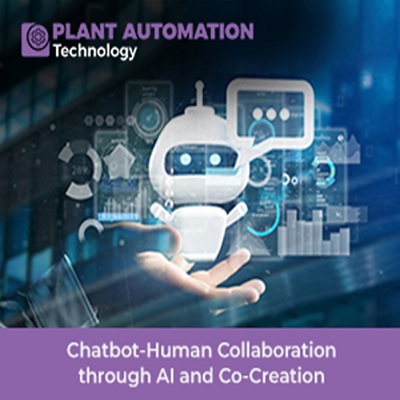Chatbot-Human Collaboration through AI and Co-Creation

Introduction
Artificial Intelligence (AI) has given rise to chatbots, interactive software programs created to mimic human conversation. Chatbots have transformed people's and businesses' engagement, providing immediate assistance, retrieving information, and delivering customized experiences. Nevertheless, to truly optimize user interactions and harness the full potential of chatbots, it is crucial to adopt a collaborative approach that combines AI capabilities with human input and co-creation. This article examines the concept of collaboration between humans and chatbots. It also examines the role of AI in facilitating this partnership, and the wide-ranging advantages it offers across different domains.
The Concept of Chatbot-Human Collaboration
1. The Power of Chatbot-Human Collaboration: Chatbot-human collaboration refers to the partnership between AI-powered chatbots and human users, where they work together to achieve a common goal. By harnessing the strengths of both humans and AI, this collaboration enables enhanced problem-solving, knowledge sharing, and the co-creation of content. Unlike traditional chatbots that rely solely on pre-programmed responses, collaborative chatbots can adapt to user needs in real-time, resulting in more meaningful and effective interactions.
2. AI's Role in Facilitating Collaboration: Artificial intelligence plays a crucial role in enabling chatbot-human collaboration. Through natural language processing (NLP) and machine learning techniques, AI-powered chatbots can understand and interpret user queries, context, and emotions. This allows them to provide accurate and personalized responses, mimicking a human-like conversation. AI also enables chatbots to learn from each interaction, continually improving their performance and understanding of user preferences.
3. Facilitating Creativity and Innovation through Co-Creation: One of the primary benefits derived from collaboration between humans and chatbots is co-creation promotion. Co-creation involves engaging users in the process of designing and developing chatbot responses, content, and the overall user experience. By embracing user co-creation, businesses can leverage their users' collective intelligence, fostering creativity and stimulating innovation. This collaborative approach ensures that chatbots are finely tuned to cater to the distinct requirements and preferences of the intended audience. This results in increased user satisfaction.
4. Enhanced Customer Support and Engagement: Chatbot-human collaboration can significantly improve customer support quality and efficiency. While chatbots can handle routine inquiries and provide quick responses, complex or sensitive issues often require expert intervention. By seamlessly transitioning between chatbots and human agents, organizations can provide seamless and personalized customer support. Chatbots can gather relevant information upfront, enabling human agents to understand user needs and respond more effectively. This synergy between chatbots and humans ultimately leads to faster issue resolution, increased customer satisfaction, and improved customer loyalty.
5. Chatbot-Human Collaboration in Knowledge Sharing: Chatbots can also be valuable tools for knowledge sharing within organizations. By integrating chatbots with knowledge management systems, employees can easily access relevant information and expertise. Additionally, chatbots can learn from human interactions and extract valuable insights, contributing to knowledge base improvement and expansion. Through this collaborative approach, chatbots become knowledge partners, helping employees find accurate information quickly and efficiently.
| Also Read: Human-Machine Collaboration: Fostering a Productive Workforce in Automated Plants |
6. Education and Training: Chatbot-human collaboration extends to education and training. Chatbots can help learners by providing personalized guidance, answering questions, and delivering learning materials conversationally. Moreover, through collaboration between chatbots and human instructors, personalized feedback and support can be provided, enhancing the learning experience. This collaboration promotes active learning, engagement, and adaptability, catering to individual learner needs.
Some benefits and applications of chatbot-human collaboration through AI and co-creation
Benefits of Chatbot-Human Collaboration
1. Enhanced User Experience: Chatbot-human collaboration enables chatbots to provide personalized and contextually relevant interactions, leading to a superior user experience. By combining AI's capabilities with human input, chatbots can better understand user needs, preferences, and emotions. This results in more satisfying and engaging conversations.
2. Enhanced Problem-Solving: Collaboration between chatbots and humans facilitates improved problem-solving capabilities. Chatbots excel at handling routine queries and offering speedy solutions, enabling human agents to dedicate their attention to more intricate or specialized issues. By seamlessly transitioning between chatbots and human agents, organizations can ensure efficient and effective problem-solving, resulting in quicker resolution of problems and heightened customer satisfaction.
3. Knowledge Sharing and Learning: Chatbot-human collaboration promotes knowledge sharing within organizations. Chatbots can serve as knowledge partners, assisting employees in accessing relevant information, troubleshooting common problems, and providing on-the-job training. Through continuous learning from human interactions, chatbots contribute to organizational knowledge base expansion and refinement.
4. Enhanced Efficiency and Productivity: Chatbots automate repetitive tasks, allowing human agents to concentrate on more value-added activities. This improves efficiency and productivity across various domains, such as customer support, sales, and administrative tasks. Chatbots can handle multiple inquiries simultaneously, ensuring faster response times and reducing wait times for users.
5. Scalability and 24/7 Availability: Chatbots provide scalable solutions that can handle high volumes of inquiries simultaneously, without human resource limitations. By offering round-the-clock support, chatbots ensure consistent and timely assistance for users across different time zones, increasing customer satisfaction and loyalty.
Chatbot-Human Collaboration Applications:
1. Customer Support: Chatbots enhance customer support by providing instant responses, guiding users through troubleshooting processes, and escalating complex issues to human agents when necessary. This collaboration improves customer satisfaction, reduces support costs, and enables organizations to deliver consistent and personalized support experiences.
2. E-commerce and Sales: Chatbots can assist customers with product searches, recommendations, and order tracking. By leveraging AI algorithms and co-creation, chatbots offer personalized product suggestions based on user preferences and purchasing history, enhancing the shopping experience and driving sales conversions.
3. Knowledge Management: Collaborative chatbots play a crucial role in knowledge sharing and management within organizations. They provide employees with easy access to relevant information, training materials, and best practices, fostering a culture of continuous learning and improvement.
4. Virtual Assistants: Chatbots act as virtual assistants, helping users with tasks such as setting reminders, scheduling appointments, and providing personalized recommendations. By leveraging AI and co-creation, chatbots offer more accurate and tailored assistance, becoming valuable digital companions.
5. Education and Training: Chatbot-human collaboration is applicable to educational settings, providing personalized tutoring, answering student queries, and offering interactive learning experiences. By co-creating educational content, chatbots can adapt to individual learning styles, supporting students on their academic journeys.
6. Healthcare and Mental Well-being: Chatbots and humans collaborating have significant implications for healthcare. Collaborative chatbots can support healthcare by offering essential medical information, facilitating appointment scheduling, and conducting preliminary symptom analysis. Moreover, they can contribute to mental health support by providing personalized resources and self-help techniques and connecting individuals with suitable professional services. Chatbots in healthcare enable enhanced accessibility and timely assistance for physical and mental well-being.
Conclusion
The potential for collaboration between chatbots, humans, and AI through co-creation is vast across multiple domains. By harnessing AI capabilities and incorporating human input, chatbots can deliver personalized, efficient, and context-aware experiences, enhance problem-solving abilities, facilitate knowledge sharing, and boost efficiency and productivity. This collaborative approach finds applications in customer support, e-commerce, knowledge management, virtual assistants, education, healthcare, and other domains, revolutionizing our interactions with technology and enriching various facets of our lives.







